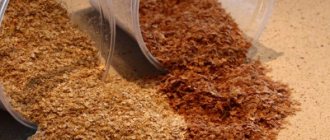Pomegranate, loved by everyone since childhood, is very good for health. The fruits of the pomegranate tree are round in shape and can range from 5–7 to 25 cm in diameter. The skin of the pomegranate is dense and shiny, depending on the variety the shade differs, but most often it is reddish-brown. Inside there are small seeds enclosed in a juicy and fleshy translucent pink-red pulp.
Pomegranate contains a huge amount of water - about 80-85%, as well as a lot of vitamins and microelements. Its seeds are also very useful, but only in very minimal quantities. Eating too many pomegranate seeds can harm your body.
What to do if the pomegranate is dry?
In this case, do not rush to get rid of the product. There is a way to properly clean even slightly spoiled fruit. Follow the described algorithm:
- Rinse and dry the fruit.
- Take a knife and any convenient container.
- Process the pomegranate.
- Divide it into parts. Tap the surface with a spoon and the grains will begin to fall into the bowl. If a film remains, don't worry. It can be removed later.
- Repeat the procedure several times until all the berries are removed.
- Now you know that cleaning pomegranates correctly is easy.
Pomegranate during pregnancy
The unique mineral and vitamin composition of the fruit makes it a very useful product for pregnant women. By regularly eating scarlet sour grains, you will quickly replenish the iron deficiency in your body - a problem that every woman in labor knows firsthand. In addition, by adding pomegranates to the expectant mother’s menu, you can normalize the functioning of the gastrointestinal tract, getting rid of attacks of nausea, which are considered a common occurrence in the early stages of pregnancy. The fruits also wonderfully quench thirst and remove excess fluid, eliminating swelling.
How to choose a tasty and ripe pomegranate
In order to enjoy a truly delicious fruit, you need to make sure it is ripe. An unripe pomegranate will be difficult to peel, and eating it is unlikely to bring much pleasure.
You can easily find out whether a fruit sold in a store is ripe if you correctly evaluate a number of parameters:
- By skin color:
- ripe pomegranate can be burgundy, red, pink and even white;
- green color will indicate the immaturity of the fetus.
- According to the appearance of the internal contents:
- juiciness, the presence of smooth and shiny grains with thin veins, indicates the ripeness of the fruit;
- soft grains of a brownish tint indicate that the pomegranate has already begun to deteriorate;
- spotted grains with traces of moss are a reason to throw away such fruit.
- By smell:
- a strong aroma indicates that the pomegranate is overripe;
- a neutral smell with a slight hint of sweetness is a sign of a ripe fruit.
- Aurally:
- a juicy and ripe fruit will make a resounding sound of hitting the metal;
- unripe fruit will sound very quietly, as if from a distance;
- An overripe pomegranate will certainly retain bruises or cracks after exposure.
- To the touch:
- you need to quickly squeeze the fruit, its softness is a sign of overripeness;
- a very hard fruit indicates that it is not yet ripe;
- an elastic pomegranate that bends under pressure and immediately returns to its shape is a ripe fruit.
We invite you to familiarize yourself with Types of Roses.
Their differences and characteristics. Sometimes, to choose a high-quality and ripe fruit, you should take the advice of a familiar seller.
How to choose ripe and sweet pomegranate
Pomegranate is a fruit with a thousand-year history. It grows mainly in Mediterranean countries, Israel, the Middle East, Spain, Sicily, and Turkey. The fruit ripening season begins in October and ends in February. It is during this period that new harvests arrive in stores and markets, which means that at this time you will definitely be able to buy fresh product.
There are more than 1000 different varieties that differ in taste, size, and peel color. But all types and varieties are united by the fact that they bring maximum health benefits. If you choose the right ripe and sweet pomegranate, you can not only enjoy the taste, but also enrich the body with valuable substances.
Below you will find useful tips for choosing.
- First of all, evaluate the appearance of the fruit - the skin should be elastic, shiny, without damage.
- The smell also matters - ripe and sweet pomegranates have a pronounced aroma, while unripe fruits, as a rule, do not smell of anything.
- Take the fruit you like in your hand and estimate its weight - the juiciest and ripest fruits are always the heaviest. Unripe ones are much easier.
- Buy pomegranates in season - they contain the maximum amount of useful substances. Those pomegranates that are sold in stores all year round can also be tasty, but due to long-term storage, some of the beneficial components in them are destroyed.
How to choose grains?
Now let's look at how to peel a pomegranate quickly and easily without splashing if you only need to use the berries.
Follow the instructions:
- Take a board and a sharpened knife. You will also need a container in which you will place the fruits.
- Cut the top of the fruit.
- Make cuts so that you get slices. Try to keep the pieces the same.
- Press down on the fruit and separate it along the cuts.
- Remove the grains and place in a separate bowl.
How to choose a ripe pomegranate in a store by color
In this case, we will determine by the color of the pomegranate peel. In order to choose the right ripe pomegranate, you need to pay attention to its color. It should have a red or bright burgundy color. It’s definitely not worth taking light pink or even with a greenish tint. I’ll even say from my personal experience that 1 out of 10 of these pomegranates will be sweetish without sourness.
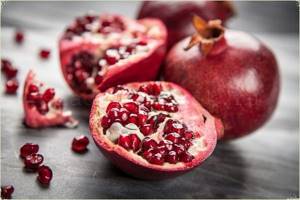
Sometimes you come across pomegranates with perfectly smooth skins, as opposed to rough ones. This suggests that the pomegranate was picked while still green and ripened later.
When purchasing, always ask where the pomegranates were brought from, because the further the road to us, the less chance that it will be delivered undamaged. Pomegranates grow in Georgia, Armenia, Tajikistan, Spain, Portugal and a number of other countries. A small note, always brush your teeth after eating pomegranate, otherwise it can lead to rapid tooth decay, the acid in pomegranate can destroy tooth enamel.
How else can you easily peel a healthy fruit?
To peel the pomegranate beautifully and easily, carefully cut off the peel from the top, without touching the grains as much as possible. Make a round cut and slowly remove the top. Now open the pomegranate and separate the grains with your fingers. You can also cut the fruit in half. Take one half, skin side up. Hold it over the bowl and tap it with a spoon until all the grains fall into the bowl. We do the same with our other half. This method is more suitable if you need pomegranate seeds to decorate a salad or cake.
Let's consider another way. This method of cleaning a pomegranate, although it takes a little longer, gives a good result. Cut the skin off the top of the pomegranates. Pour water into a deep bowl and place the fruit in it. Break it in half. Now we disassemble the pomegranate directly under water, separating the grains from the peel. We take out the peel and put it aside, and throw the water with the grains into a colander.
How to clean
Peeling a pomegranate is a special art. Each cook has his own secrets, nuances, and methods. It all depends on what purpose you are going to peel the pomegranate for. If you plan to make juice, the easiest thing to do is cut the fruit into four equal parts and use a tablespoon to separate the seeds from the peel. An important nuance - cut pomegranates in an apron or in clothes that you are not afraid of getting dirty. The ripe fruit contains a huge amount of juice. Pomegranate stains are very difficult to remove. If you do get dirty, immediately take off your clothes and fill them with water.
There are other ways to clean pomegranate. Here is one of them:
- Score the pomegranate crosswise (like an orange) using a sharp fruit knife.
- Break the skin by pulling it to the side.
- Place a bowl under the grains and hold the fruit over it, skin side up.
- Tap it with the blunt side of a kitchen knife.
After such actions, all the grains should come off and fall into the container. Thanks to this method, you can keep all the grains intact, which is important in those situations if you use them for salads or snacks and do not plan to make juice.
How to properly and quickly peel a pomegranate
https://www.youtube.com/watch?v=RzCg1_eQR1g
Regardless of which method you choose to extract juicy seeds, the first thing you should do is thoroughly rinse the fruit. If desired, you can use a dishwashing sponge. Such measures are necessary because suppliers often treat its surface with special substances that resemble wax in structure. If you do not want to harm your health and spoil the taste of the product, you should not ignore this procedure.
We invite you to familiarize yourself with the interior design of a kitchen in the country (75 photos)
The shell is hard and dense
It seems that if the peel is dry, then the fruit is definitely ripe. But that's not true. A good pomegranate peel should be dense, but slightly elastic. And one more sign of a ripe fruit: the shell fits the grains so that they can be felt underneath it.
A dry peel indicates that the fruit has been stored for a long time. On the other hand, a smooth, slightly damp skin may be a sign that the pomegranate was picked unripe, and almost white, sour grains are hidden inside such a beautiful fruit.
Needless to say, the peel of the fruit not only of pomegranates, but also of other fruits should be free of damage, spots of rot and other signs of wilting? But minor dark spots on the skin of pomegranates are quite acceptable.
Found a violation? Report content
Peeling a pomegranate in 6 movements
To properly clean a whole pomegranate in less than 1 minute, you need to prepare a number of auxiliary items in advance:
- a small knife with a sharp blade;
- cutting board;
- container for pomegranate seeds;
- large spoon;
- silicone baking dish;
- a form that allows you to make dumplings;
- large sieve for flour.
This method allows you to quickly peel a pomegranate without losing a drop of precious and healthy juice, without getting dirty or making a mess in the kitchen. There are several options for such cleansing, let’s look at each of them step by step:
Clean quickly and easily
To begin, rinse off the paraffin, a special protective compound, in warm water and pat dry with a towel. Place the pomegranate on a cutting board. Carefully, cutting shallowly, without pressing too hard, so as not to damage the integrity of the grains, cut off the upper part of the peel (like a watermelon, remove the cap along with the corolla).
Now white partition films inside become visible, which seem to divide the grains into sections. You need to make cuts exactly along the borders (along these partitions). Then break the fruit along these cuts, but not completely, but so as to separate the segments.
Turn the fruit opened in this way into a deep bowl, lightly tap with a wooden spoon and separate the grains.
Video instructions on how to properly and quickly peel a pomegranate.
Unripe pomegranate what to do
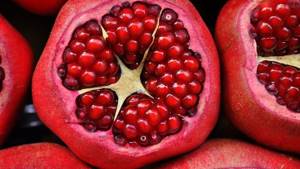
Pomegranate contains a huge amount of useful microelements and fiber. Nutritionists advise both men and women, and children over three years old to eat it. But it is not recommended to give pomegranate juice to children under three years of age - it irritates the delicate gastric mucosa and can cause allergies. Older children should be offered pomegranate juice diluted with still water.
With regular consumption of pomegranates, immunity increases, and the blood is enriched with iron - an essential trace element, the lack of which leads to anemia.
2 About color and crown
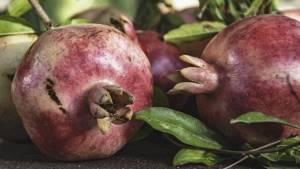
The color of a ripe pomegranate is brown-red. There are fruits of bright crimson color, sometimes orange-red, pale pink and even white. It all depends on the variety and time of ripening of pomegranates.
An unripe pomegranate has a green peel that is hard to the touch. The top of the pomegranates is topped with a flower cup that resembles a royal crown. The taste of the fruit depends on its color and condition. In ripe pomegranates, this very calyx is dry, with a color that matches the shade of the fruit. A green, slightly shriveled tail indicates that the fruit has not yet ripened and is not worth buying.
3 The main thing is taste and skin
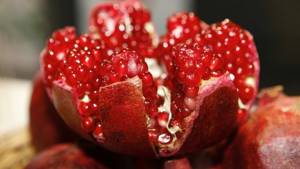
Faceted grains that glow from the inside with a ruby color are not always an indicator of excellent taste. So at the market you should not refuse the seller’s offer to taste the pomegranate.
The skin of a high-quality fruit is thin, dry and tightly covers the grains. If the skin looks too dry, then there is a high risk of purchasing last year’s pomegranates with tasteless grains without juice.
Touch the pomegranate with your hand. If the skin is slightly rough, then feel free to buy it. A smooth, as if wet skin may indicate that the fruit was picked from the tree unripe, it simply did not have time to be saturated with juices.
4 Checking for ripeness
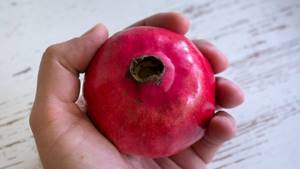
The color of the crust can be any. A prerequisite is a light glossy sheen, which is noticeable if you examine the garnet in daylight. Brown spots and a black core indicate rot, which could have formed due to poor storage conditions. Cracks on a pomegranate are signs of an overripe fruit. If the fruit is shiny and there are no external defects, then try pressing on the crust. Was there a subtle cracking sound? Everything is fine: the grains inside are ripe, juicy, sweet. Excessive softness of the fruit may be a sign that during transportation the grenades froze, banged against each other and managed to deteriorate.
Where to begin?
First you need to rinse the fruit under running heated water. This will allow you to wash off the paraffin that is used to cover the fruit for long-term storage. Otherwise, the composition will end up on your hands and get on the grains. After completing the procedure, gently blot the surface with a towel, but do not press too hard.
Simple tips
To cut a pomegranate without much effort, follow the algorithm:
- Choose a sharpened knife. Cut and remove the top. The berries and the veins between them will remain inside.
- Make cuts where the peel goes. Do not touch the grains. The result will be small slices.
- If you followed the instructions on how to properly peel a pomegranate, you will separate the fruit into pieces.
- Perform the described operation with the remaining part of the fruit.
Choose light yellow and pink garnets
Breeders have developed a sufficient number of varieties of pomegranates with different peel colors. There are not only red fruits, but also light pink, yellow and even blue. Many of us think that the color of a fruit is an indicator of its ripeness. This is true only with respect to the green peel.
Such fruits are really unripe, and the seeds in them are sour. But the claim that the redder the pomegranate peel, the sweeter it is, is a myth. For example, pink and yellow varieties have red seeds inside, like jasper, very sweet and tasty.

Properties of pomegranate
- Rich source of vitamins, amino acids and trace elements
- The juice refreshes, improves appetite, normalizes the functioning of the gastrointestinal tract
- Fresh fruits increase hemoglobin, restore the body when exhausted
- Useful for colds; people suffering from heart disease, atherosclerosis, anemia; improves eye nutrition
- The peel of the fruit can get rid of worms.
- Pomegranate juice destroys tooth enamel due to its organic acid content. Should be diluted with water. Harmful to people with gastritis and bad teeth.
Composition and benefits of pomegranate juice
The chemical composition of this aromatic drink contains more than fifteen amino acids necessary for humans! It is these substances that can cleanse our organs of radiation, toxins and waste. Pomegranate juice will help restore normal functioning of the gastrointestinal tract after feasts and normalize appetite, raising hemoglobin levels. In addition, this product is simply irreplaceable during cold seasons.
Previously, it was successfully used to treat and prevent scurvy, which makes the juice an ideal way to restore vitamins in the body in the spring. This drink has a powerful antiseptic and diuretic effect, so it is recommended for pulmonary diseases, as well as liver and kidney diseases.
Method using a ladle
To quickly peel a pomegranate using this method, you can use a small ladle and a tablespoon.
In this case, the fruit is cut into two segments transverse to the veins so that only the peel is damaged. Then a spoon is inserted in one direction between the skin and the pulp and turned in a circle. Similar manipulations should be performed with the other half. The result is a whole peeled pomegranate and cap-shaped peel.
Clean without splashing
Now let's look at how to clean a pomegranate without splashing. Everything is very simple. You just need to use water when peeling a pomegranate. Wash the fruit and blot it with a towel or napkin. Using a sharp knife, make cuts on the skin, trying not to touch the grains. This is done so that the juice does not run out. Pour water into a small bowl and put the pomegranate in it. Leave it in the water for 15-20 minutes.
https://www.youtube.com/watch?v=9YF3nul-dEo
The fruit will be saturated with water and will be easier to clean. We immerse our hands in water and right in this bowl we begin to separate the pomegranate into slices. You should end up with several individual slices in a bowl of water. We clean them from the film, thereby releasing the pomegranate seeds. After this, do not pull out the grains immediately, let them lie in the water for a couple more minutes. The entire film floats to the surface. Let's remove it. And the grains remain lying at the bottom. Drain the water and transfer the grains to a plate.
How to eat pomegranate correctly
There are no strict rules regarding how to properly eat pomegranate. You can choose grains or cut into slices and enjoy the taste. Juices, sweets, marmalade, and the famous Georgian delicacy “churchkhela” are also made from this fruit. Pomegranate juice is very useful for anemia and low immunity. Nutritionists recommend giving them to children and drinking them during the recovery period after serious illnesses.
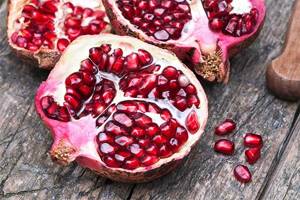
How much can you eat per day
There are also no strict restrictions regarding the daily intake. But a large amount of pomegranate can have a bad effect on the functioning of the digestive system. It contains a lot of acids, which can cause stomach and intestinal upset, leading to pain and cramps.
The maximum daily dose for an adult is 200–250 grams, for a child – up to 150 grams. But it is important to remember that everything is individual - even 50 grams of grains can harm someone. For example, with irritable bowel syndrome, colitis, pancreatitis and gastritis with high acidity, pomegranate can provoke an exacerbation and worsening of the condition.
With the permission of your attending physician, you can increase the daily dose of pomegranate consumption if, for example, you plan to use this product for medicinal purposes.
Is it possible to eat at night and on an empty stomach?
It is not recommended to eat pomegranate on an empty stomach, as it contains a lot of fruit acids. They irritate the gastric mucosa and stimulate the production of gastric juice. It is better to eat grains and drink juice from them only after a snack, so as not to get heartburn or worsen diseases of the digestive system as a result.
On an empty stomach, it is sometimes recommended to drink juice diluted with boiled water in a 1:1 ratio. This remedy helps cleanse the body of toxins and waste.
Eating pomegranate in the evening, just before bed, is also not a good idea. Firstly, due to its powerful vitamin composition, consumption of this fruit may impair the quality of sleep. Secondly, pomegranate stimulates the digestive system, which may cause you to experience hunger at night and discomfort in the stomach and intestines. Pomegranate also has a pronounced laxative and diuretic effect, which is why it is better to consume it in the first half of the day.







